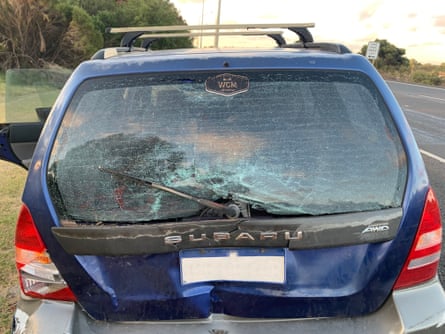My body knew the accident was coming a few minutes before it did. I’d just picked up my friend from the centre of a regional town and pulled back on to the highway when I felt a tension across my thighs like a shot of cortisol.
Moments later, waiting at the last set of lights before the open road, another car slammed into the back of my Subaru Forester and – almost a decade after getting my first car – my thoughts turned to insurance for the first time.
If you can, claim through the other party
Immediately I sensed my car was a write-off – it was a hefty whack, although my body absorbed the impact OK. The other driver was suitably apologetic, which made things a lot easier; they accepted full liability, and we swapped licence details and got out of there before the lights had gone red again. I’d taken some quick photos at the accident site, then pulled over shortly afterwards to inspect the damage more closely and get more photos.
Petrol prices are soaring – here’s how you can save money on running a carRead more
By the next morning, my diligent opposite number had already lodged a claim with his insurer, which suited me.
Jane Foley, the acting director of casework at the Financial Rights Legal Centre, advises that it’s always better to use the other party’s insurance if they have it. “You don’t have to pay the excess,” she says. “And then you’re not bound by the terms of your own policy.”
You might, for example, have an agreed value as part of your car insurance policy, and you’d still be limited to that despite considerations like the car market inflating due to supply chain issues.
‘Do not give your power to the assessor’
According to Foley, I got the next step wrong, although I got away with it. “My first advice is do not let the other insurer inspect your car,” she says. “The only reason they want to inspect your car is to then devalue it.”
 View image in fullscreenJesse Noakes sensed the Forester was a write-off, a suspicion that was quickly confirmed. Photograph: Jesse Noakes
View image in fullscreenJesse Noakes sensed the Forester was a write-off, a suspicion that was quickly confirmed. Photograph: Jesse Noakes
In my case, I’d already confirmed my intuition of a write-off with a friendly mechanic who declined to do the paperwork but pointed me round the corner to the insurer’s nominated repairer, who immediately deemed my Forester a “total loss”. However, they also filed a bunch of their own photos with the insurer, which were then the basis for endless references to “sun damage to the paint job” as grounds for reducing the valuation.
“I always tell people: do not give your power to the assessor,” Foley says.
I was happy to green light the write-off, but if you feel more attached to your car and believe it should be repaired, there are time limits you should be aware of. “The insurer has 10 days to assess it and get back to you,” says Uta Mihm, an insurance specialist at consumer advocate Choice. “And if you don’t want to write it off, you only have seven days to dispute that.”
Do your research
For me, it was time to play hardball. I knew everything I said on the phone would be recorded, so I made sure I had my ducks in a row before taking the call from the claims assessor.
The most important thing to clarify was the likely market rate for my vehicle. Redbook, Glass Guide and The Drive Guide are industry price guides and by looking under the hood of my car and finding the VIN code, I was then able to use an online tool to confirm the make, model and year of my vehicle.
 View image in fullscreenThe price comparison table Jesse Noakes made to show the insurer the value of his vehicle. Photograph: Google Sheets
View image in fullscreenThe price comparison table Jesse Noakes made to show the insurer the value of his vehicle. Photograph: Google Sheets
To stack up the case, I borrowed a tip from the journalist Royce Kurmelovs, who wrote Just Money after his own experience after a car accident. Kurmelovs suggests making a table with the make, model and year in one column and the prices similar vehicles are selling for in another, which you can find by scanning resale sites like CarSales, Gumtree and Facebook Marketplace. It turns out that lots of people are trying to off-load mid-2000s Subaru Foresters, so I had a plethora of references.
While Foley advises presenting a formal letter of demand to the other party to resolve the claim, I opted to email their insurer with a clear and compelling outline of factors bearing on my expected valuation, with links to citations such as the price comparison table I had made.
Consider personal injury
One thing that wasn’t priced into the equation is personal injury. Although my passenger woke up three days later unable to lift his arm above his shoulder, it turns out he’d just slept on it badly.
-
Sign up for the fun stuff with our rundown of must-reads, pop culture and tips for the weekend, every Saturday morning
Sign up to receive Guardian Australia’s weekend culture and lifestyle email
As Mihm notes, compulsory third party insurance, which is paid during vehicle registration, covers these costs – provided you are not at fault for the accident. “You’re covered for pain and suffering, loss of wages, claims management expenses, care and support such as medical treatment and rehabilitation,” she says.
Tie up loose ends
The insurer rang around some wreckers but couldn’t find anyone who’d pay them for my damaged car, so I got to keep it too.
In the end, I was able to score more for my Forester on the second-hand private market than selling it for salvage to a wrecker. I coaxed it up the coast in the dead of night (wearing four layers with all the windows down, to combat exhaust fumes pouring in through the boot) and sold it on Gumtree.
By now, the insurer had come back to me with an offer that was more than 50% up on their initial proposal, passing the threshold I originally set myself.
All that remained was to insist the insurance pay for a hire car, and we had a deal I was happy to settle.



